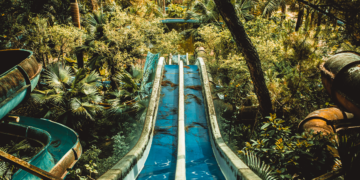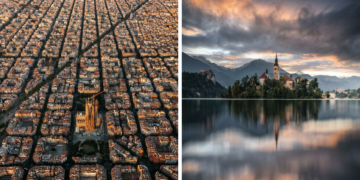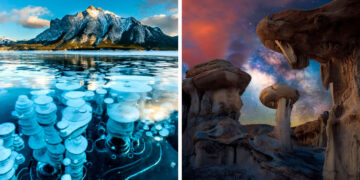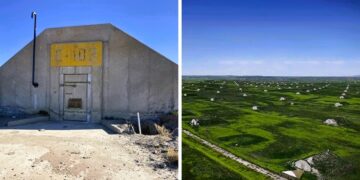It takes someone genuinely adventurous to venture through a vast natural cavern millions of years old. While spelunking through most caves, you expect to find pale, blind creatures, massive stalactites and stalagmites, and plenty of darkness. But these incredible caves have something unique to offer anyone who dares to explore their depths. I don’t know which of these I should attempt to cross off my bucket list first!
01. Cave Of The Crystals (Mexico)
Discovered in 2000 by two brothers drilling below the Naica mine near Chihuahua, the Cave of Crystals is a glittering spectacle with temperatures reaching up to 112 degrees. Many of the crystals, estimated to be about 600,000 years old, can be several feet thick, and the smaller ones are razor-sharp. Forget diamonds; if you love a woman, take her to a cave with crystals bigger than her wildest dreams.
02. Waitomo Glowworm Cave (New Zealand)
Formed over 30 million years ago, this cave is one of Earth’s most brilliant displays of bioluminescence. Thousands of glowworms, native to New Zealand, hang from the cave’s walls on strands of silk and use their dazzling blue light to attract prey. You may never find a cavern filled with fairies, but this is pretty close.
03. Grotto Azzurra (Italy)
If you’re ever near Capri, Italy, you NEED to take a trip to the Blue Grotto. Once thought to be inhabited by sirens and devils, the cave is known for its radiant blue water. When the sunlight enters the cave through an underwater entrance, the water filters out the red light and leaves only the blue light to illuminate the cavern. The result is an incredible phenomenon that leaves no need for color enhancements on all the photos you’ll take there.
04. Vatnajökull Glacier Cave (Iceland)
Formed entirely out of ice, glacier caves are best to visit in the autumn and winter when the ice isn’t as likely to collapse and the glaciers don’t move as quickly. Many also take on a bright blue color, standard in parts of glaciers (such as the underside, or in this case, the inside) that have not been turned white by the sun’s UV rays. Would you be daring enough to venture inside a cave that could melt?
05. Phraya Nakhon Cave (Thailand)
The Phraya Nakhon is inside the Khao Sam Roi Yot National Park, an incredible cave with a fascinating history. Sunlight filters through the top of the structure’s collapsed ceiling, illuminating the Kuha Karuhas pavilion, initially built in 1890 for King Chulalongkorn. Since its construction, other local kings have visited the cave and left their signatures on its walls. This is one cave that is majestic in every sense of the word.
06. Marble Caves (Chile)
Anyone willing to travel to the General Carrera Lake in Patagonia is in for a serious treat. Crystal-clear water tinted a dazzling blue by glacial silt accentuates the intricate designs in what many call the most fantastic cave network. The water is also responsible for forming the unique shape of the caverns and walls, making an Earthly cave appear very otherworldly.
07. Cave At The Mutnovsky Volcano (Russia)
It may seem unbelievable to think that an ice cave could form at the base of a volcano, but that’s the sort of thing that tends to happen in Russia. Hot springs have carved out the cave’s incredible shapes, while light that filters in through the roof creates an incredible color display of greens, purples, and blues. Many who have found the cave accidentally stumbled upon it while exploring the area around the volcano, making this mysterious ice structure even more incredible.
08. Dongzhong Cave (China)
It’s thousands of years old, but now, this otherwise ordinary cave serves as a classroom for 186 students and eight teachers. Dongzhong, meaning “in cave” in Chinese, began as an educational structure in 1984 and is now one of the most excellent schools. I would have been way more excited to attend science class if I knew it was happening here.
09. Fingal’s Cave (Scotland)
Although this cave on Staffa Island looks like it was painstakingly hand-carved by someone with an affinity for hexagons, its incredible geometric structure is entirely natural. Hot lava that helped form the cave cooled and cracked in a hexagonal pattern. As the cracks extended down the mass of lava and shrank, it created the columns that the cave is famous for today. Nature can be a very peculiar artist sometimes.
10. Reed Flute Cave (China)
Okay, I’ll be honest—the lighting in this colorful cave is entirely artificial. But does it matter? The Reed Flute cave has been a popular destination for over a thousand years, as evidenced by transcriptions dating back to 792 AD. It was named for the reeds that grow just outside the entrance, which can be made into flutes. The formations inside the cave are just incredible, and combined with all the surreal lighting, they prove that amazing things can happen when man and nature’s efforts combine.
11. Ellison’s Cave (USA)
Northeast Georgia is home to Ellison’s cave, which contains the appropriately named Fantastic Cave Pit. At 586 feet deep, it’s the bottomless known cave pit in the United States and a dream come true for a dedicated rappeler. A rock dropped from the top takes about eight seconds to reach the ground. If dropping almost 600 feet into a deep, dark cave is what you fancy, then a trip to Georgia is definitely in order.
12. Kyaut Sae Cave (Myanmar)
According to legend, Kyaut Sae Cave was initially used as a place of hiding for locals who wanted to hide from the Mongols in the 13th century. Now, the cave has another particular purpose. A Buddhist temple, built on the side of a cliff, is the entrance to the cave, which acts as a meditation area for monks. Tourists are welcome to visit the temple, but few choose. Perhaps a place as incredible as this should be left undisturbed as possible.
13. Son Doong Cave (Vietnam)
The world’s largest cave is located in Vietnam’s Quang Binh province. First found by a local man in 1991, the cave is nearly 700 feet wide, 500 feet high, and almost six miles long. Many of the cave’s structures that have formed in its millions of years of existence are massive enough to make explorers appear minuscule in comparison. This must be what an ant feels like in our everyday world.
14. Eisriesenwelt Ice Caves (Austria)
The world’s largest ice caves were discovered in the late 19th century, which is pretty late considering how awe-inspiring they are. The entire labyrinth stretches twenty-five miles, and just like all ice caves, its structure, both outside and inside, constantly changes due to the ice that melts and refreezes. Any dedicated spelunker would be missing out if they didn’t check out Eisriesenwelt, but they’d be well-advised to bundle up first.
15. Ordinskaya (Russia)
Exploring Ordinskaya, or the Orda Cave, in Russia’s Ural region is the perfect adventure for anyone who enjoys their time in the water. The cave consists of over 3 miles of underwater chambers, and while it is possible to get lost, rest assured that seeing where you’re going won’t be an issue— the water is so clear that you can see up to fifty yards ahead. After seeing this incredible place, you might never want to come up on dry land again.
16. Carlsbad Caverns (USA)
Located in what is now New Mexico, Carlsbad Caverns National Park is home to many impressive caves, all of which were created between 4 and 6 million years ago. Sulfuric acid formed from mixed water dissolved the area’s limestone, widening cracks in the rock and eventually creating the caves we know today. What makes these caves truly notable are the massive deposits of gypsum, clay, and silt, whose presence gives the caves a fantastical and almost cartoonish look.
17. Barton Creek Cave (Belize)
When you first enter this cave, you might not find it too special—until you notice the skulls. The Maya used Barton Creek Cave for ceremonial and burial purposes, and many of their artifacts (and remains) still lie amongst the cave’s natural geological formations. While beautiful, the entrance to the cave somehow manages to give off the vibe that the place you’re about to enter is far more than just a rocky structure—it’s sacred ground.
18. Jeita Grotto (Lebanon)
Upon entering the Jeita grotto, you immediately understand why its name translates to “roar” of water. The lower grotto floods your ears with the rushing water and air echoing through the cave’s chambers. As you travel more profoundly, though, the sounds of nature are replaced by a profound silence, allowing you to look around and take in the dazzling beauty of the cave’s intricate geography without any distractions.
19. Cango Caves (South Africa)
In the Western Cape Providence of South Africa lies a series of caverns with dramatic and colorful limestone features. Artifacts show that many of the main cave entrances once served as homes for people living in the Middle and Later Stone Ages, but now the structures are used for tours for those who love a bit of adventure. Although about four kilometers of the caves have been discovered, only a quarter is open to the public. But one kilometer is enough for those who want to be awestruck by one of the African continent’s greatest wonders.
20. Aven Armand (France)
If you dare to venture 100 meters underground, the Aven Armand will make it worthwhile. It boasts over 400 unique stalagmites, including the largest one known worldwide, which stands nearly 100 feet tall. While the Eiffel Tower is undoubtedly a sight, consider checking out Mother Nature’s beautiful sculptures if you ever visit France.
I will never forget that nature created such impressive structures. Share this with everyone you know whose craving for travel will never be satisfied.
Like what you’re reading? Subscribe to our top stories.






























































Discussion about this post